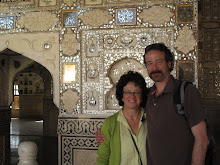 positive light) in India before going there but I didn’t really understand the reality of it until we became the target of every peddler, beggar, tour guide and huckster within view whenever we stepped outside of our bubble. By the end of our trip, we had become hardened to the constant haranguing and just made our way through to our destination without making eye contact. When visiting the Taj Mahal in Agra, our driver had to leave us at the edge of the “green zone”, a mile-wide radius that prohibits cars in order to protect the white marble of the Taj and at this point in the trip, we had become old hands at steeling ourselves to the constant entreaties and “Hallo Madam’s”, briskly walking past all the pleading rickshaw drivers directly to the gate.
positive light) in India before going there but I didn’t really understand the reality of it until we became the target of every peddler, beggar, tour guide and huckster within view whenever we stepped outside of our bubble. By the end of our trip, we had become hardened to the constant haranguing and just made our way through to our destination without making eye contact. When visiting the Taj Mahal in Agra, our driver had to leave us at the edge of the “green zone”, a mile-wide radius that prohibits cars in order to protect the white marble of the Taj and at this point in the trip, we had become old hands at steeling ourselves to the constant entreaties and “Hallo Madam’s”, briskly walking past all the pleading rickshaw drivers directly to the gate.At every museum and historical site there are separate tickets for visitors (usually around 250 INR’s, or $6) and Indians (usually 20 rupies, or about 40 cents). At the Taj Mahal the entry is 750 rupies for visitors and I think it was over 50 rupies for Indians, which explained why not many natives were inside the gates. I can understand the dual pricing system for tourist site and certainly we can afford it but the dual system wears a bit thin over time.

At our first rest stop on the way to Jaipur, our guide and driver disappeared for about a half an hour and Peter and I were left locked out of the car, wondering where they had gone. It was after the second stop that we realized that they head to the “crew members” section and we were expected to go to the tourist restaurant or the gift shop and spend money for things at highly inflated prices. We also learned from our friends in Agra that our guides took us to shops where they get a cut of the proceeds …sometimes up to 40 percent! If you understand that this just the way tourist business is done in India then I guess it shouldn’t be bothersome… but it bothered me to have an engaging conversation with our driver (Jantin spoke very good English because he had gone to a catholic school in Kerela) and then have him disappear down below while we were ushered up to the clip joints with all the other tourist sheep. We were the masters and they were the servants… but they were taking a good piece out of us at the same time.
 I picked up a copy of the book “The White Tiger” by Aravind Adiga at the airport on the way home and found it hard to put down. It won the Booker prize in 2008 and it doesn’t pull any punches in talking about the underbelly of the Indian economy and the vast underclass who is struggling to survive and, at times, move up and out of oppression. The main character comes from “the darkness” --rural and impoverished India-- and becomes a driver to an upper class family in Delhi. I could picture the drivers in the novel as our drivers, waiting for hours on end as we did our site seeing and shopping. The class system is alive and well in India and Adiga makes the case that it’s a self-imposed oppression that keeps everyone in line and willing to put up with the system… so there’s not a need for a dictatorship-type government like in China to keep the peace. Not surprisingly, “The White Tiger” created quite a bit of negative press in India when it first came out.
I picked up a copy of the book “The White Tiger” by Aravind Adiga at the airport on the way home and found it hard to put down. It won the Booker prize in 2008 and it doesn’t pull any punches in talking about the underbelly of the Indian economy and the vast underclass who is struggling to survive and, at times, move up and out of oppression. The main character comes from “the darkness” --rural and impoverished India-- and becomes a driver to an upper class family in Delhi. I could picture the drivers in the novel as our drivers, waiting for hours on end as we did our site seeing and shopping. The class system is alive and well in India and Adiga makes the case that it’s a self-imposed oppression that keeps everyone in line and willing to put up with the system… so there’s not a need for a dictatorship-type government like in China to keep the peace. Not surprisingly, “The White Tiger” created quite a bit of negative press in India when it first came out.

No comments:
Post a Comment